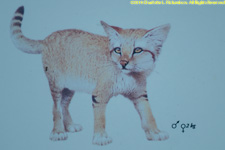
Zoological Center Tel Aviv / Ramat Gan Safari houses the largest animal collection in the Middle East. We came here hoping to see the sand cats. However, no visible sand cats (it was raining). This zoo has successfully bred sand cats.
Animals in the African Park:
Arabian Oryx: Adapted to the desert climate, they need little water and sparse vegetation. They were hunted to extinction in the wild by the 1970's, but were reintroduced in nature preserves in the Arabian Peninsula, Jordan, and the Arava thanks to zoo breeding programs.
White Rhinoceros: Live in small herds and feed on wild grasses. In Africa they are hunted for their horns, which sell for very high prices in Asia. The horns are thought to have magical powers in Chinese medecine and folk arts. The female's horn is narrower and longer than the male's.
Lion: Lions hunt only once every few days.
Marabou stork: They feed on carrion, fish, and eggs, helping to keep the area clean. They spread their large wings to expose them to the sun to help get rid of feather parasites.
Giraffe: Tallest mammal.
Waterbuck: Have reddish, long, shaggy coats. Only the male has horns. They live in wooded areas. When in danger they jump into the water and stay there until the danger passes.
Somali Wild Ass: The ancestor of the domestic donkey, it is the rarest of all horses with only about 500 remaining in Somalia and Eritrea.
Grant zebra: This relative of the horse has wide stripes, with each animal having an individual stripe pattern.
Scimitar-Horned Oryx: Live in the sands of the North African desert in herds of 10-12 animals. Both the males and females have scimitar-shaped horns. Hunted almost to extinction in the wild, zoo-bred oryx have been returned to nature reserves in Tunisia, Morocco, and Senegal.
Hippopotamus: During the hot hours of the day they submerge themselves in water. During the evening they come out to pasture. They usually give birth on the river's edge but occasionally they bear their young in the water. They live in large herds with one dominant male.
Nyala: Males differ from females in coat pattern and color, and females lack horns.
Thomson Gazelle: A small gazelle with a distinct black line on its side. The male has longer and wider horns than the female. Dominant males control harems of females. The remaining males form bachelor herds.
Eland: The largest antelope, attempts have been made to domesticate elands for milk and meat. The females in the herd all bear their young almost simultaneously. The young are all kept together in a baby nursery, watched by their mothers in shifts.
Gnu: Common in the East African plains, gnus migrate with zebra herds, following the rain to green pastures.
Addax: Live in herds of about twenty individuals. Their broad hooves enable them to gallop on sand dunes without sinking. Their originsl habitat was the deserts of North Africa, where they are now almost extinct.
Flamingo: Live in huge flocks of thousands. Flamingos feed on algae and small crustaceans, which give their feathers their pink hue. They build mud nests on the ground in dense colonies.
Other zoo animals and birds:
©2015, 2016 Mermaid Underwater Photographic. All Rights Reserved.
Contact us at mermaid@underwater.org.
Last modified 29 June 2016